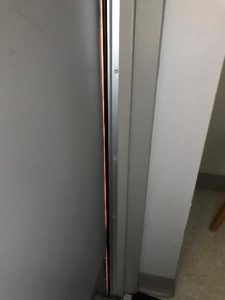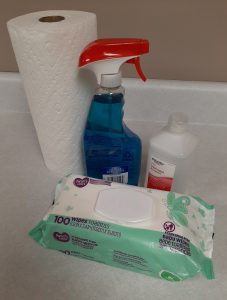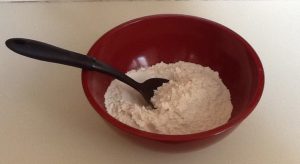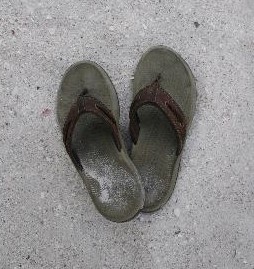
by Judy Corbus | Nov 2, 2020
Ahhh…Fall! I love this time of year – changing leaves, cooler temperatures, and lower humidity make it a joy to be outside. It’s also the perfect time to give your house some TLC after the summer heat and before the cold winter winds blow. Regular maintenance keeps your home healthy, can lower your power bill, and saves you money on costly repair jobs as you catch them early on.

Clear roofline “valleys” of debris to reduce the risk of leaks. Photo source: Judy Corbus
Here are eight things to check inside and outside your home this fall:
Check weather-stripping and caulking around windows and doors. Check for signs of leaks, then repair or replace as needed. This keeps your heated or cooled air in and pests out.
Paint exposed wood. Check eaves, doors and frames, and other wood surfaces for chipped or flaking paint and touch up with a fresh coat to protect against rotting.
Check windows and doors for smooth operation. Install or patch screens, lubricate window tracks and door hinges, and repair as needed.
Clean gutters and downspouts. Use gloved hands or a trowel to scoop out debris from gutters. Flush downspouts with water or use a drain “snake” to clear blockages. Make sure they discharge water 2-3 feet away from the house to protect the foundation; a downspout extender can funnel water further away from the house. Clear gutters and downspouts allow water to drain properly from your roof to reduce the risk of leaks.
Clean roofline “valleys.” The V-shaped area where two roof slopes meet is the perfect catch-all for leaves, pine straw, and other debris. If allowed to accumulate, this debris can trap moisture, leading to a breakdown of the roofing material and eventual leaks. Use a leaf blower to clear the valleys to keep your roof dry and water flowing freely off it.
Clean the chimney. If you plan to use your fireplace, have it inspected and cleaned by a professional chimney cleaning service before you light the first fire of the season. This will remove creosote, an oily by-product of burned wood that builds up inside the chimney and increases the risk of chimney fires.
Change the batteries in all smoke and carbon monoxide detectors. This ensures the batteries are fresh, whether your detectors are hardwired, with a battery backup, or completely battery-operated. Test detectors regularly to ensure they are operating properly.
Have your heating and cooling system serviced. Your service professional will make necessary tune-ups, so your system operates efficiently for a comfortable environment and lower utility bills.
For a complete home maintenance checklist, click here.
Adapted from: https://www.fcs.uga.edu/extension/healthy-housing#mantained

by Judy Corbus | Aug 27, 2020
Eeekkk! A roach! Quick – where’s the bug spray? That seems like a logical way to get rid of the pesky critter, right? But what if the roach is in your kitchen? Or you have pets or small children? Is there a less toxic way to keep pests out of your home?
Integrated Pest Management, or IPM, uses a combination of methods to help you:
- Stop pests
- Inspect and monitor for pests
- Identify pests
- Have a game plan to protect your home
- Know if your plan is working
Pests, like people, need food, water, and shelter to thrive, so if you eliminate one or all these factors, you increase your pest control success. You can use IPM to prevent indoor and outdoor pests and solve existing pest problems.

If you can see light around the door edge, insects can enter. Photo source: UF/IFAS
Exclusion is a major part of prevention in IPM; it prevents outdoor pests from entering.
- Check the weather-stripping around exterior doors and windows – if you can see light, pests can enter. Did you know an American cockroach can enter through a gap the thickness of a quarter?
- Install door sweeps on exterior doors so insects can’t enter under the door – be sure the sweep brushes the floor.
- Patch or replace window and door screens to keep flying insects out.
- Use sealants around doors and windows to fill tiny gaps where pests can enter. It will help to conserve energy, too!
- Cover vent pipe openings, like dryer vents, on your home’s exterior with strong mesh or other covering to keep rodents and other small animals from entering.
Our Habits
We sometimes make it easier for pests to move in and thrive in our home due to our habits. Here are a few easy ways to prevent pests:
- Wash dishes promptly. Pests feast on food particles so wash dishes immediately after meals.
- Quickly clean up grease and spills. Just like dirty dishes, grease and food spills attract pests so clean them as soon as they occur. This also will keep the spill from spreading, saving you cleaning time in the long run.
- Store food items in sealed plastic containers. This keeps pests out and food items fresher for longer.
- Clean on a routine schedule. Regular sweeping, vacuuming, mopping, dusting, and general cleaning removes food sources for pests and creates a healthier indoor living space for you and your family.
- Get rid of clutter. Piles of paper, clothes, and other items can provide a dark, cozy home in which pests can hide and multiply. Organize these areas so your home is less inviting to pests. Cockroach control alone can significantly reduce allergen levels.
- Dispose of recycling frequently. This removes a breeding ground for pests.
- Inspect incoming goods or items before bringing them into your home. This will reduce the risk of “stowaways” entering.
- Use plastic bins for long-term storage. Cockroaches love cardboard boxes and paper bags so transfer items you plan to store for longer than three to six months to plastic storage bins with tight-fitting lids.
Treatment
There are a variety of treatment options for controlling pests.

Use window cleaner, rubbing alcohol, or baby wipes to disrupt ant trails in your home. Photo source: Judy Corbus, UF/IFAS Extension
- Window cleaner, rubbing alcohol, baby wipes: Ants travel in trails to and from their food source, emitting pheromones, or scent trails, to “mark” their path to the food. To disrupt ant trails, spray window cleaner on or apply rubbing alcohol to a paper towel or use baby wipes to wipe the ant trail. This removes the scent trail so the ants cannot find their way back to their food.
- Whole home gel bait: These products come in a syringe-type applicator with formulations for cockroaches and ants. Examine your home carefully to see where these pests are entering and apply a pea-sized dollop of the gel bait at the entry points. The pests eat the bait and return to their nest, where the gel bait eliminates the nest. The gel bait can be used anywhere in and around the house where cockroaches or ants are found and is more effective than treating kitchens and bathrooms only, a common pest control practice. Gel bait works well behind appliances, swtichplates, and outlet covers. Reapply gel bait periodically to keep pests from returning. You may need to rotate brands, as pests can develop immunity over time.
So, the next time you see a bug in your home, consider IPM before you reach for the spray. For more information about integrated pest management for homes, contact your local UF/IFAS Extension office.

by Judy Corbus | Nov 23, 2019

Flour is considered a raw ingredient so bake before eating. Photo credit: Judy Corbus
There is something about cooler weather that brings out the urge to bake and fill my home with delightful aromas befitting the season. Enjoying the fruits of my labor is a tasty experience but here are 8 tips I follow during prep and afterwards to keep my baked goods safe.
- Wash my hands, baking tools, appliances, and work surfaces with soap and hot water before, during, and after food prep – clean as I go!
- Break eggs in a separate bowl before adding to the batter. This keeps shell fragments out of the batter and, if the egg is spoiled, I don’t ruin the whole project.
- Never eat unbaked flour – this includes dough and batter. Flour is considered a raw ingredient, as it is minimally processed before being packaged for use. Wheat stalks in the field come in contact with birds, rodents, and other bacteria sources, which can spread E. Coli. Raw eggs can contain salmonella so bake foods to the proper internal temperature and resist the urge to lick the bowl, spoons, and beaters.
- Use a food thermometer to check internal temperatures – a brown crust does not equal doneness. Insert the probe food thermometer in the product center and wait for the temperature to maintain a level reading. This Baked Goods Internal Temperatures Chart is a handy guide for determining internal doneness. If the outside is browned but it’s not done in the middle, lay foil lightly over the crust to prevent overbrowning and continue baking until the proper internal temperature is reached.
- Always refrigerate perishable ingredients, pies, cheese-filled breads or baked goods with perishable filling ingredients (this includes eggs, custards, cheese, pizza, meats, casseroles, cream pies, puddings, and crème puffs) within 2 hours of use, preparation, or serving at room temperature. Cookie, scone, biscuit, pie, and yeasted dough may be refrigerated or frozen for later use.
- Cool baked products on clean wire cooling racks on a clean counter or table away from where raw batter or dough are prepared. Don’t cool in the baking pans or directly on counter tops.
- Wash my hands before packaging cooled products.
- Store plain yeast breads at room temperature no longer than 1 to 2 days; freeze for longer term storage. Do not refrigerate unless the bread is filled with perishable ingredients.
Enjoy your favorite baked treats safely this holiday season and beyond!
Sources: Home Baking Food Safety 101
HomeBaking.org
What’s Cooking America
North American Millers Association

by Judy Corbus | Jul 5, 2019

Visit places close to home for a vacation that won’t break the budget. (Photo source: UF/IFAS)
“Summer” and “vacation” seem to go hand-in-hand, as school is out and schedules are a little more laid back. Now that summer is here, you may be making plans for a getaway to your favorite spot. Perhaps, you are saving up for that dream trip next summer but you’d still like to take a break and have some fun this year. How can your family and you enjoy yourselves without breaking the bank? The answer might be right in your own backyard!
- Plan a staycation. Rather than traveling out of the area, use your home as base and plan some fun activities – family game time, camping out in the backyard and making s’mores, or running through the sprinklers and having a water balloon fight. Or just relax with a good book and a glass of lemonade or catch a few zzzs under a tree. The key is to turn off the devices, forget about work, and not worry about projects around the house – they will be there after you “return.”
- Plan day trips. These can be a part of your staycation, too. If you live fairly close to the beach, pack the car and head out early to enjoy the surf before temperatures rise. Make a day of it by enjoying the sunset before heading home. State parks also offer hiking and biking trails, boating and canoeing, swimming, playgrounds, picnic areas, and other fun activities. Florida boasts of 175 state parks, trails, and historic sites around the state so your next adventure may be just a short drive away. Check out https://www.floridastateparks.org/ for a park near you.
- Check out local events. Libraries and museums often feature special exhibits for free or a nominal charge. Several years ago, I visited a traveling exhibit about the Titanic at an arts center an easy drive from home. It made for an enjoyable and educational afternoon! Contact your local library or museum for a schedule of summer program offerings.
- Take part in a service project. A number of families are opting to use some of their vacation time to help others in need in their communities – projects include yard work, painting, basic home repairs, assisting with a food pantry/clothes closet, and serving meals to the homeless. These projects may be sponsored by a community service organization or church. During this past spring, local media outlets reported on several groups of college students representing campus ministries, fraternities, and other organizations who volunteered their Spring Break time to assist with Hurricane Michael clean-up and recovery. Participating in a service project as a family can be a meaningful way to give back to the community and make a difference locally. Contact your place of worship or local service organizations for opportunities in your area.
This summer, “recharge” without a super charge to your wallet!
Source: https://www.daveramsey.com/blog/i-need-a-staycation

by Judy Corbus | Mar 22, 2019

Unexpected expenses? Be prepared with a “rainy day” fund. Photo credit: UF/IFAS Northwest District
It began as a normal six-month dental check-up – no pain, no problems. After the X-rays, cleaning, and exam, my dentist informed me the X-ray showed an abscess above a back molar. The next thing I knew, I was headed to the endodontist for a root canal then back to my dentist for a permanent filling – wow! Who saw that coming? That was a classic “Life happens” moment!
We all face those unexpected events – a flat tire, a faulty alternator, an appliance on the fritz, a medical emergency. The question is, do we have the funds available to cover it? An emergency, or “rainy day,” fund helps us to handle those surprise expenses more easily, reducing our need to borrow to pay for them.
How much should we have in our emergency fund? A minimum of $1000 is a good starting point – that typically will cover most emergencies. A fully funded emergency reserve is three to six months of expenses; some financial advisors recommend eight to 12 months of expenses. If you are the sole breadwinner in your household, funding it to six months or beyond gives you a greater cushion. What is significant about these numbers? If you were unable to work due to a job loss, layoff/furlough, illness, or a family emergency, you would have funds available to tide you over until you could get back on your feet. Having funds to keep you afloat for a few months removes a lot of pressure and may allow you to explore your options without feeling like you need to take the first job offer that comes along because you “need the money.”
How do you fund your emergency fund? Look at your finances and, if you aren’t already in the habit of doing so, set aside a portion of your paycheck for savings right off the top – pay yourself first! Even if it’s just a few dollars per paycheck, those dollars will add up. If you receive a pay raise, save the difference between the new amount and your pre-raise salary. Your income tax refund is another great way to jump start your emergency fund – use Form 8888 Allocation of Refund to direct deposit your refund into one or more accounts.
It is a fact of life that life happens – be prepared with an emergency fund!
For more information on saving for emergencies, please see UF/IFAS FCS 7014 Money and Marriage: Saving for Future Use.











